Jackson M.J. Micro and Nanomanufacturing
Подождите немного. Документ загружается.


Microfabrication Using X- ray Lithography 81
2.4.10 Resist Requirements
An X- ray resist ideally should have high sensitivity to x- rays, high
resolution, resistance to dry and wet etching, thermal stability of
greater than 140 ^C, and a matrix or resin absorption of less than
0.35 jum'^ at the wavelength of interest. These requirements are
only those for semiconductor production with x- ray lithography. To
produce high-aspect-ratio microstructures with high lateral toler-
ances an additional set of requirements is required. The unexposed
resist must be absolutely insoluble during development. This means
that a high contrast (y) is required. The resist must also exhibit very
good adhesion to the substrate and be compatible with the electro-
forming process. The latter imposes a resist glass transition tem-
perature (Tg) greater than the temperature of the electrolyte bath
used to electrodeposit metals between the resist features remaining
after development (say, at 60 ^C). To avoid mechanical damage to
the microstructures induced by stress during development, the resist
layers should exhibit low internal stresses. If the resist structure is
the end product of the fabrication process, further specifications de-
pend on the application
itself,
for example, optical transparency and
refractive index for optical components or large mechanical yield
strength for load-bearing applications. Owing to excellent contrast
and good process stability known from electron beam lithography,
PMMA is the preferred resist for deep-etch synchrotron radiation li-
thography. Two major concerns with PMMA as the x- ray lithogra-
phy resist are a rather low lithographic sensitivity of about 2 J/cm^ at
a wavelength Xc of 0.84 nm and a susceptibility to stress cracking.
For example, even at shorter wavelengths,
Xc
= 0.5 nm, over 90 min
of irradiation are required to structure a 500
ju
m thick resist layer
with an average ring storage current of 40 mA and a power con-
sumption of
2
MW at the 2.3-GeV ELSA synchrotron. The internal
stress arising from the combination of a polymer and a metallic sub-
strate can cause cracking in the microstructures during development,
a phenomenon PMMA is especially prone to. X- ray resists ex-
plored for lithographic applications include poly(lactides), for ex-
ample, poly(lactide-co-glycolide) (PLG); polymethacrylimide
(PMI);
polyoxymethylene (POM); and polyalkensulfone (PAS).
PLG is a new positive resist that is more sensitive to x- rays by a
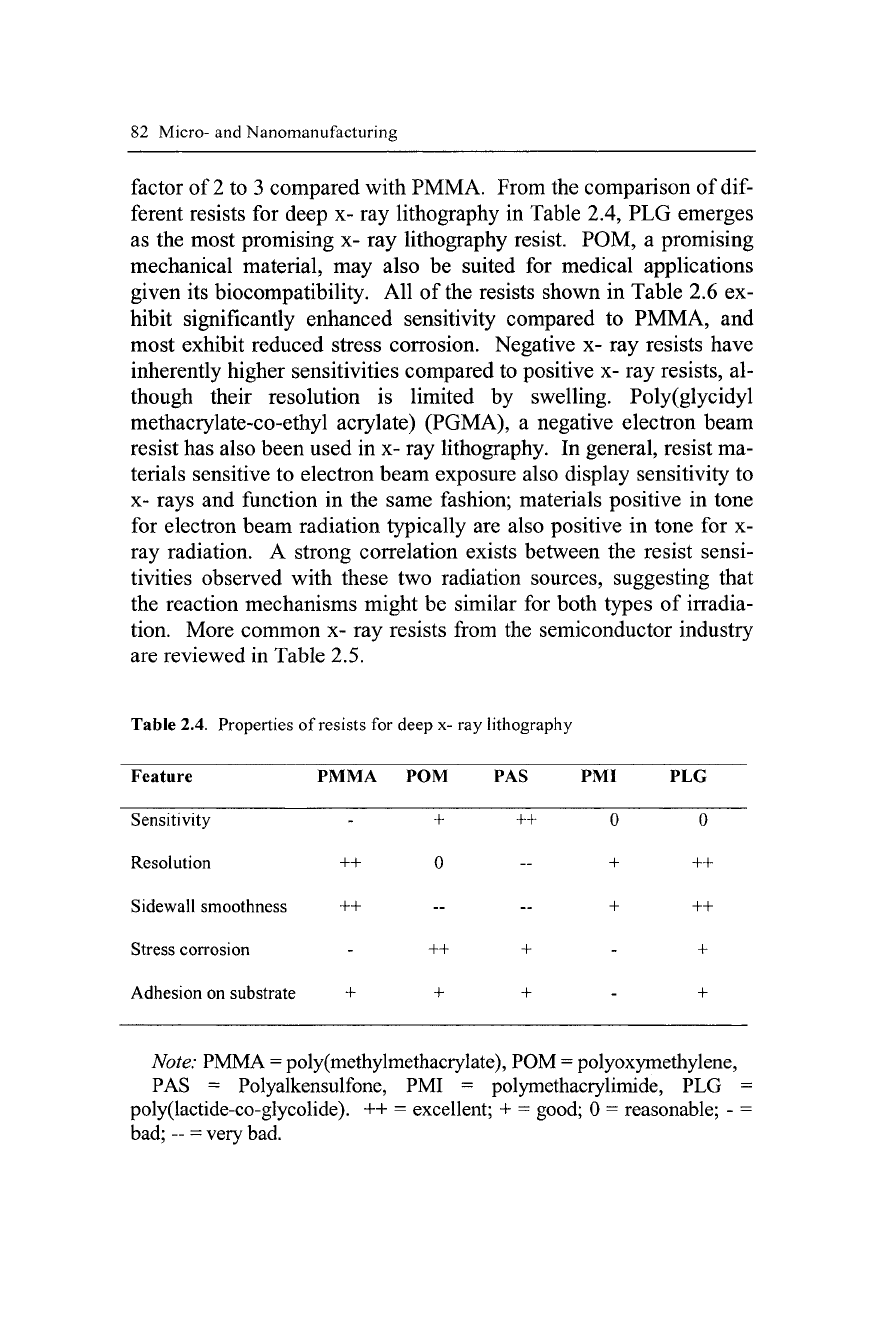
82 Micro- and Nanomanufacturing
factor of
2
to 3 compared with PMMA. From the comparison of
dif-
ferent resists for deep x- ray Hthography in Table 2.4, PLG emerges
as the most promising x- ray lithography resist. POM, a promising
mechanical material, may also be suited for medical applications
given its biocompatibility. All of the resists shown in Table 2.6 ex-
hibit significantly enhanced sensitivity compared to PMMA, and
most exhibit reduced stress corrosion. Negative x- ray resists have
inherently higher sensitivities compared to positive x- ray resists, al-
though their resolution is limited by swelling. Poly(glycidyl
methacrylate-co-ethyl acrylate) (PGMA), a negative electron beam
resist has also been used in x- ray lithography. In general, resist ma-
terials sensitive to electron beam exposure also display sensitivity to
X- rays and function in the same fashion; materials positive in tone
for electron beam radiation typically are also positive in tone for x-
ray radiation. A strong correlation exists between the resist sensi-
tivities observed with these two radiation sources, suggesting that
the reaction mechanisms might be similar for both types of irradia-
tion. More common x- ray resists from the semiconductor industry
are reviewed in Table 2.5.
Table 2.4. Properties of resists for deep x- ray lithography
Feature PMMA POM PAS PMI PLG
_
Sensitivity
Resolution
Sidewall smoothness
Stress corrosion
Adhesion on substrate
-
++
++
-
+
+
0
--
+4
+
0
+
+
0
++
++
+
Note:
PMMA = poly(methylmethacrylate), POM = polyoxymethylene,
PAS = Polyalkensulfone, PMI = polymethacrylimide, PLG =
poly(lactide-co-glycolide). ++ = excellent; + = good; 0 = reasonable; -
=
bad;
—
= very bad.
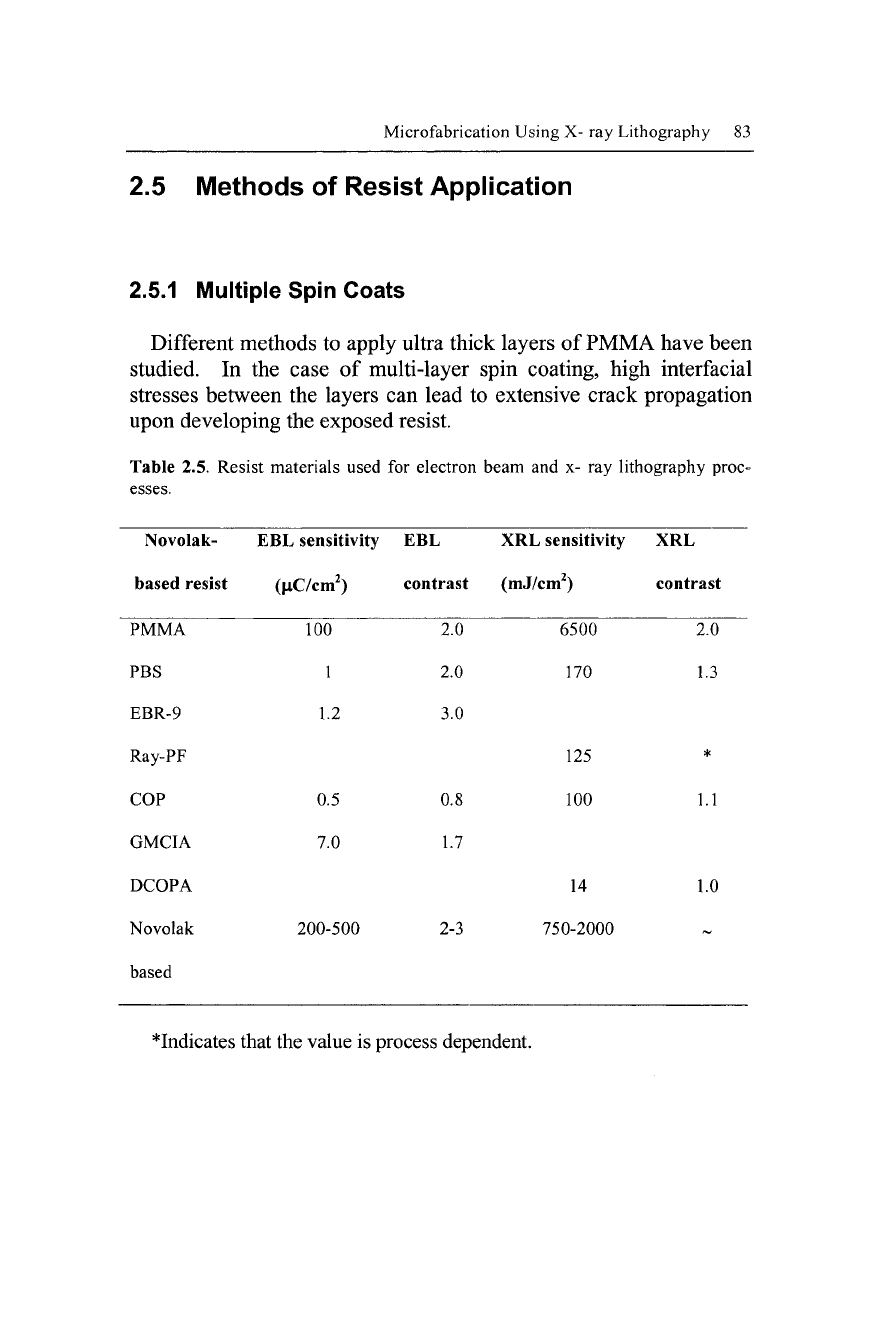
Microfabrication Using X- ray Lithography 83
2.5 Methods of Resist Application
2.5.1 Multiple Spin Coats
Different methods to apply ultra thick layers of PMMA have been
studied. In the case of multi-layer spin coating, high interfacial
stresses between the layers can lead to extensive crack propagation
upon developing the exposed resist.
Table 2.5. Resist materials used for electron beam and x- ray lithography proc=
esses.
Novolak-
based resist
PMMA
PBS
EBR-9
Ray-PF
COP
GMCIA
DCOPA
Novolak
based
EBL sensitivity
(fiC/cm^)
100
1
1.2
0.5
7.0
200-500
EBL
contrast
2.0
2.0
3.0
0.8
1.7
2-3
XRL sensitivity
(mJ/cm^)
6500
170
125
100
14
750-2000
XRL
contrast
2.0
1.3
*
1.1
1.0
-
*Indicates that the value is process dependent.

84 Micro- and Nanomanufacturing
2.5.2 Commercial PMMA Sheets
High molecular weight PMMA is commercially available as pre-
fabricated plate and several groups have employed freestanding or
bonded PMMA resist sheets for producing x- ray lithography struc-
tures.
After overcoming the initial problems encountered when at-
tempting to glue PMMA foils to a metallic base plate with adhe-
sives,
this has become the preferred method in several laboratories.
2.5.3 Casting of PMMA
PMMA also can be purchased in the form of a casting resin. In a
typical procedure, PMMA is in situ polymerized from a solution of
35 wt% PMMA of a mean molecular weight of anywhere from
100,000 g/mol up to 10^ g/mol in methylmethacrylate (MMA). Po-
lymerization at room temperature takes place with benzoyl peroxide
(BPO) catalyst as the hardener (radical builder) and dimethylaniline
(DMA) as the initiator. The oxygen content in the resin, inhibiting
polymerization, and gas bubbles, inducing mechanical defects, are
reduced by degassing while mixing the components in a vacuum
chamber at room temperature and at a pressure of 100 mbar for 2 to
3 min. In a practical application, resin is dispensed on a base plate
provided with shims to define pattern and thickness and subse-
quently covered with a glass plate to avoid oxygen absorption.
2.5.4 Resist Adhesion
Smooth surfaces such as Si wafers with an average roughness, Ra,
smaller than 20 nm pose additional adhesion challenges that are of-
ten solved by modifying the resist
itself.
To promote adhesion of
re-
sist to polished untreated surfaces, such as a metal-coated Si wafers,
coupling agents must be used to chemically attach the resist to the
substrate. An example of such a coupling agent is methacry-
loxypropyl trimethoxy silane (MEMO). With 1 wt% of MEMO
added to the casting resin, excellent adhesion results. The adherence
is brought about by a siloxane bond between the silane and the hy-
drolyzed oxide layer of the metal. The integration of this coupling
agent in the polymer matrix is achieved via the double bond of the
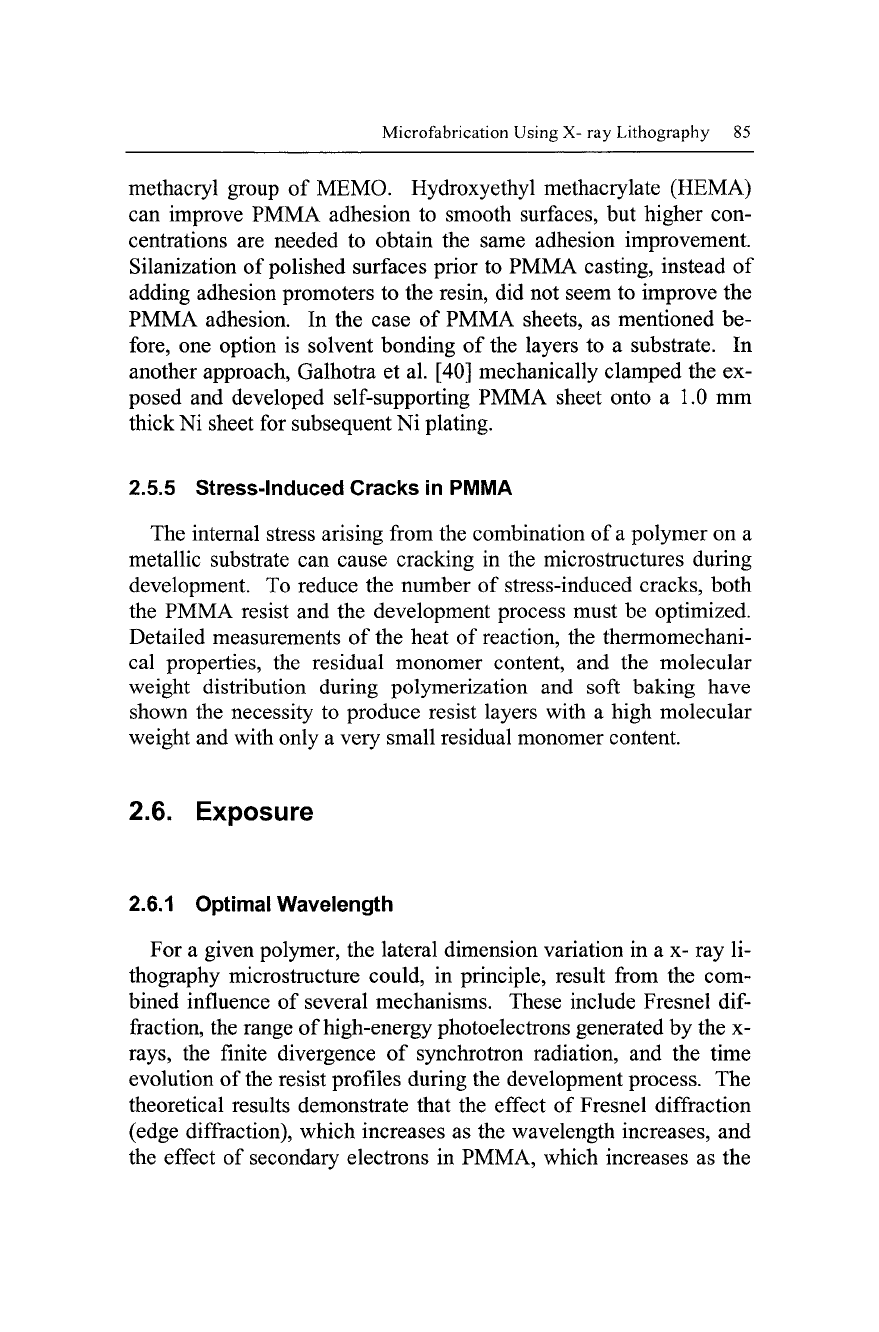
Microfabrication Using X- ray Lithography 85
methacryl group of MEMO. Hydroxy ethyl methacrylate (HEM A)
can improve PMMA adhesion to smooth surfaces, but higher con-
centrations are needed to obtain the same adhesion improvement.
Silanization of polished surfaces prior to PMMA casting, instead of
adding adhesion promoters to the resin, did not seem to improve the
PMMA adhesion. In the case of PMMA sheets, as mentioned be-
fore,
one option is solvent bonding of the layers to a substrate. In
another approach, Galhotra et al. [40] mechanically clamped the ex-
posed and developed self-supporting PMMA sheet onto a 1.0 mm
thick Ni sheet for subsequent Ni plating.
2.5.5 Stress-Induced Cracks in PMMA
The internal stress arising from the combination of a polymer on a
metallic substrate can cause cracking in the microstructures during
development. To reduce the number of stress-induced cracks, both
the PMMA resist and the development process must be optimized.
Detailed measurements of the heat of reaction, the thermomechani-
cal properties, the residual monomer content, and the molecular
weight distribution during polymerization and soft baking have
shown the necessity to produce resist layers with a high molecular
weight and with only a very small residual monomer content.
2.6. Exposure
2.6.1 Optimal Wavelength
For a given polymer, the lateral dimension variation in a x- ray li-
thography microstructure could, in principle, result from the com-
bined influence of several mechanisms. These include Fresnel
dif-
fraction, the range of high-energy photoelectrons generated by the x-
rays,
the finite divergence of synchrotron radiation, and the time
evolution of the resist profiles during the development process. The
theoretical results demonstrate that the effect of Fresnel diffraction
(edge diffraction), which increases as the wavelength increases, and
the effect of secondary electrons in PMMA, which increases as the
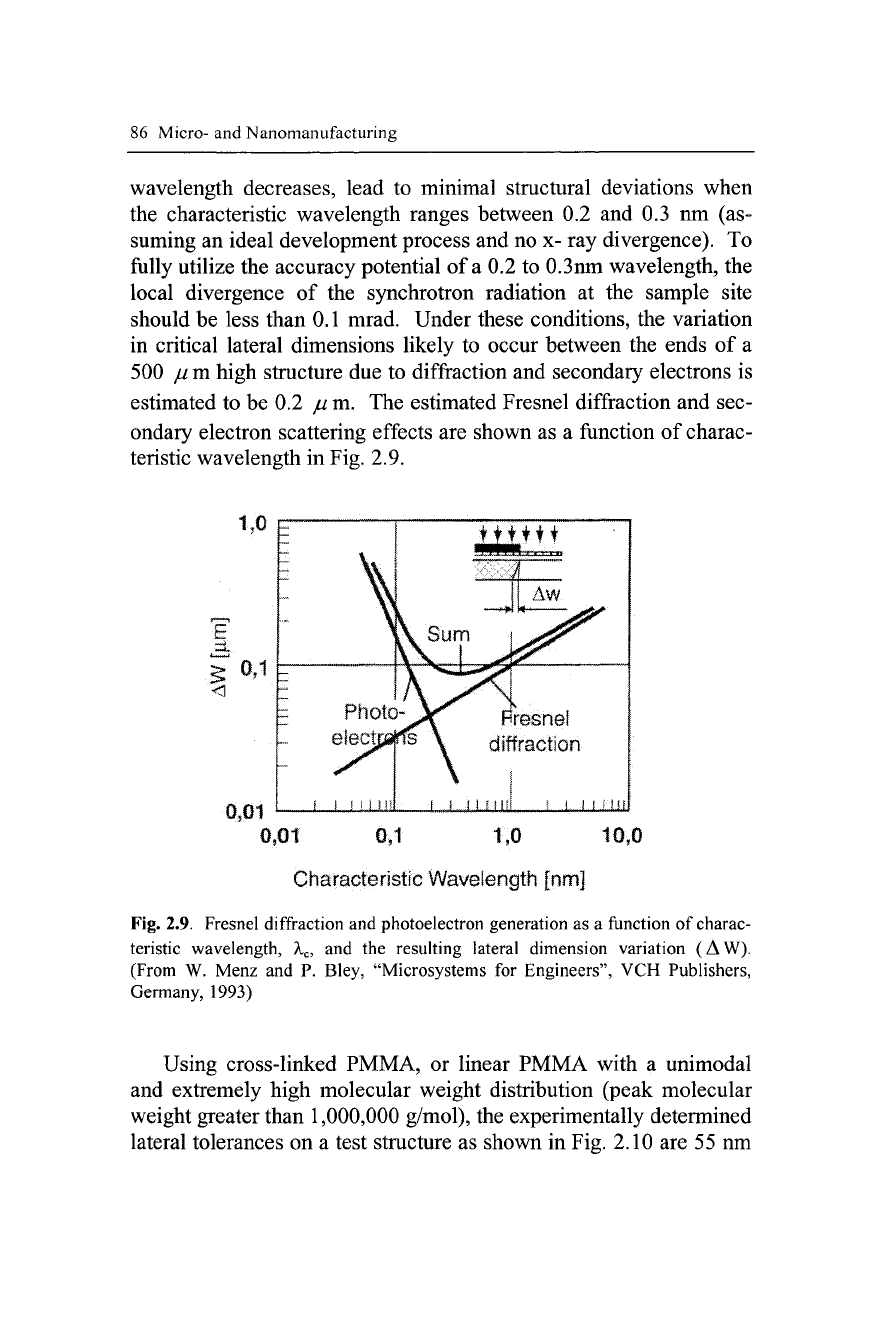
86 Micro- and Nanomanufacturing
wavelength decreases, lead to minimal structural deviations when
the characteristic wavelength ranges between 0.2 and 0.3 nm (as-
suming an ideal development process and no x- ray divergence). To
fully utilize the accuracy potential of a 0.2 to 0.3nm wavelength, the
local divergence of the synchrotron radiation at the sample site
should be less than 0.1 mrad. Under these conditions, the variation
in critical lateral dimensions likely to occur between the ends of a
500
ju
m high structure due to diffraction and secondary electrons is
estimated to be 0.2
ju
m. The estimated Fresnel diffraction and sec-
ondary electron scattering effects are shown as a function of charac-
teristic wavelength in Fig. 2.9.
0,01
0,01 0,1 1,0 10,0
Characteristic Wavelength [nm]
Fig. 2.9. Fresnel diffraction and photoelectron generation as a function of charac-
teristic wavelength, X^, and the resulting lateral dimension variation (AW).
(From W. Menz and P. Bley, "Microsystems for Engineers", VCH Publishers,
Germany, 1993)
Using cross-linked PMMA, or linear PMMA with a unimodal
and extremely high molecular weight distribution (peak molecular
weight greater than
1,000,000
g/mol), the experimentally determined
lateral tolerances on a test structure as shown in Fig. 2.10 are 55 nm
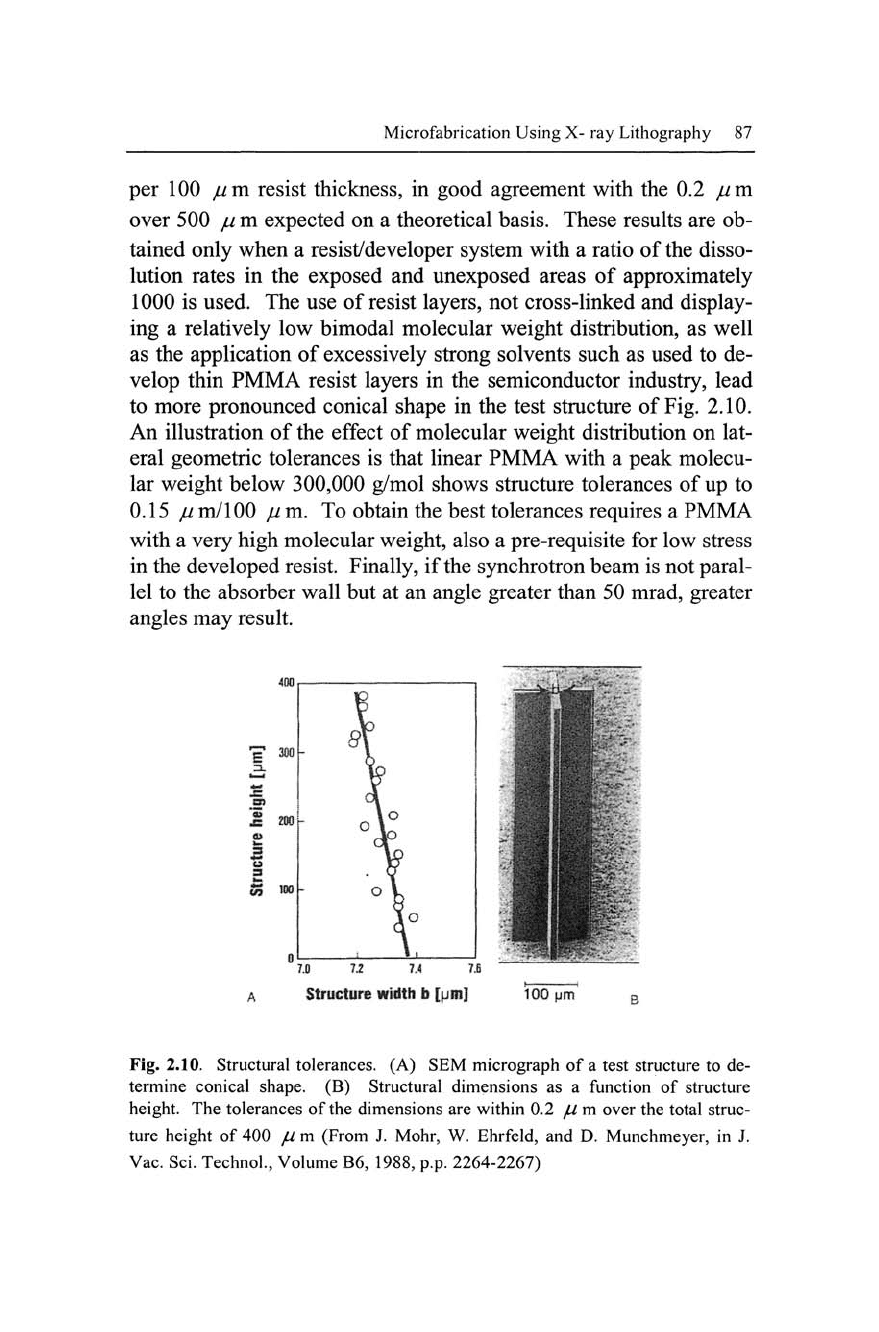
Microfabrication Using X- ray Lithography 87
per 100 jum resist thickness, in good agreement with the 0.2 jum
over 500
ju
m expected on a theoretical basis. These results are ob-
tained only when a resist/developer system with a ratio of the disso-
lution rates in the exposed and unexposed areas of approximately
1000 is used. The use of resist layers, not cross-linked and display-
ing a relatively low bimodal molecular weight distribution, as well
as the application of excessively strong solvents such as used to de-
velop thin PMMA resist layers in the semiconductor industry, lead
to more pronounced conical shape in the test structure of Fig. 2.10.
An illustration of the effect of molecular weight distribution on lat-
eral geometric tolerances is that linear PMMA with a peak molecu-
lar weight below 300,000 g/mol shows structure tolerances of up to
0.15 jum/lOO jum. To obtain the best tolerances requires a PMMA
with a very high molecular weight, also a pre-requisite for low stress
in the developed resist. Finally, if the synchrotron beam is not paral-
lel to the absorber wall but at an angle greater than 50 mrad, greater
angles may result.
7.0 7,2 7.4 7.6
Structure width b [pm]
100 pm g
Fig. 2.10. Structural tolerances. (A) SEM micrograph of a test structure to de-
termine conical shape. (B) Structural dimensions as a function of structure
height. The tolerances of the dimensions are within 0.2
jU
m over the total struc-
ture height of 400
jU
m (From J. Mohr, W. Ehrfeld, and D. Munchmeyer, in J.
Vac.
Sci. Technol., Volume B6, 1988, p.p. 2264-2267)

88 Micro- and Nanomanufacturing
2.6.2 Deposited Dose
The X- ray irradiation of PMMA reduces the average molecular
weight. For one-component positive resists, this lowering of the av-
erage molecular weight causes the solubility of the resist in the de-
veloper to increase dramatically. The average molecular weight
making dissolution possible is a sensitive function of the type of de-
veloper used and the development temperature. The molecular
weight distribution, measured after resist exposure, is unimodal with
peak molecular weights ranging from 3000 g/mol to 18,000 g/mol,
dependent on the dose deposited during irradiation.
The peak molecular weight increases nearly linearly with in-
creasing resist depth; that is, decrease of the absorbed dose. Fig.
2.11 A illustrates a typical bimodal molecular weight distribution of
PMMA before radiation, exhibiting an average molecular weight of
600,000. The gray region in this figure indicates the molecular
weight region where PMMA readily dissolves; that is, below the
20,000 g/mol level for the temperature and developer used.
Since the fraction of PMMA with a 20,000 molecular weight is
very small in non-irradiated PMMA, the developer hardly attacks
the resist at all. After irradiation with a dose
Ddv
of 4 kJ/cm^, the
average molecular weight becomes low enough to dissolve almost
all of the resist (Fig.
2.1
IB). With a dose
Ddm
of 20 kJ/cm^ all of
the PMMA dissolves swiftly (Fig. 2.11C). At a dose above
Ddm,
the
microstructures are destroyed by the formation of bubbles. It fol-
lows that to dissolve PMMA completely and to make defect-free
microstructures, the radiation dose for the specific type of PMMA
used must lie between 4 and 20 kJ/cm^.
These two numbers also lock in a maximum value of
5
for the ra-
tio of the radiation dose at the top and bottom of a PMMA structure.
To make this ratio as small as possible, the soft portion of the syn-
chrotron radiation spectrum is usually filtered out by a pre-absorber
(for example, a 100 //m thick polyimide foil [Kapton]) to reduce
differences in dose deposition in the resist.
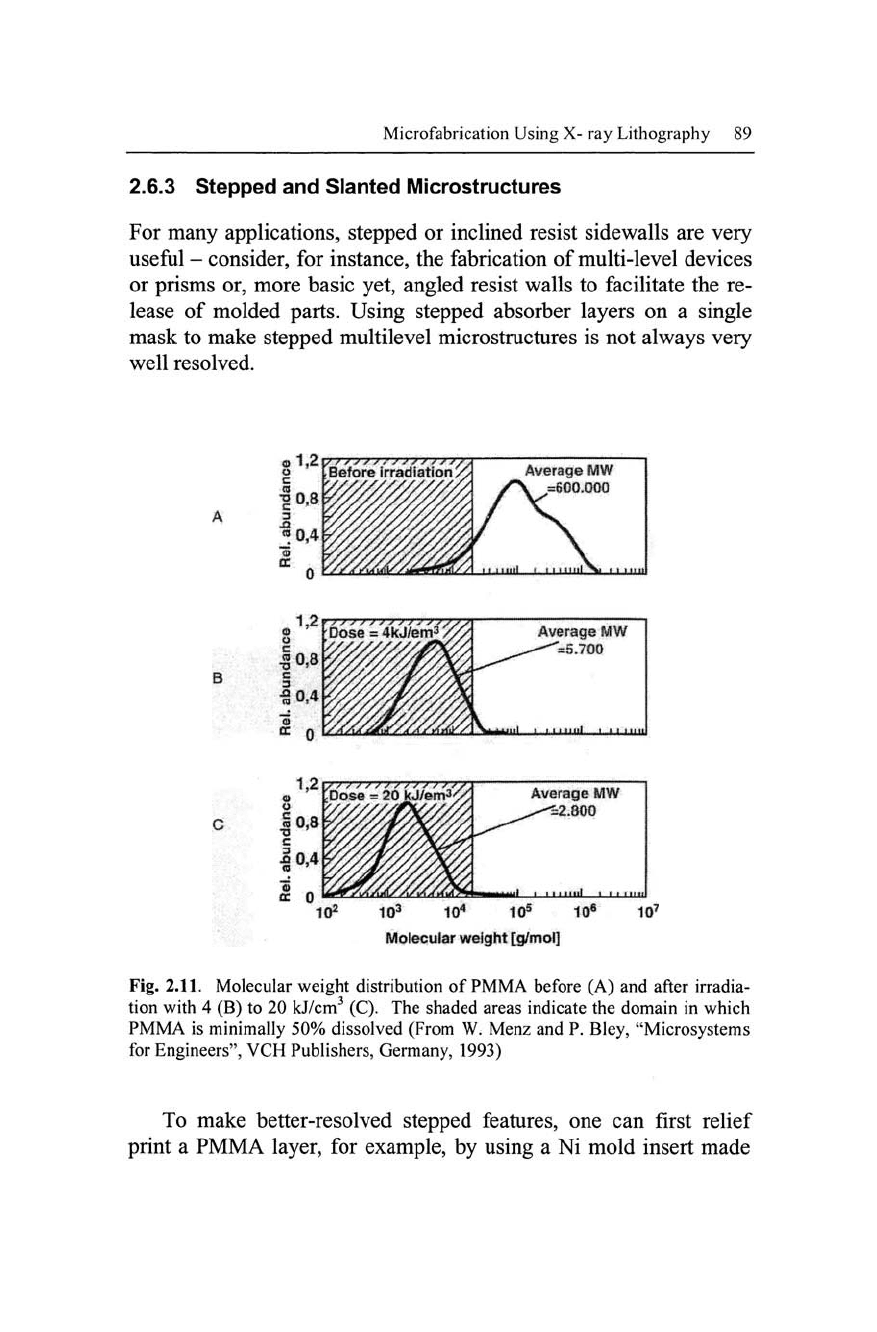
Microfabrication Using X- ray Lithography 89
2.6.3 Stepped and Slanted Microstructures
For many applications, stepped or inclined resist sidewalls are very
useful - consider, for instance, the fabrication of multi-level devices
or prisms or, more basic yet, angled resist walls to facilitate the re-
lease of molded parts. Using stepped absorber layers on a single
mask to make stepped multilevel microstructures is not always very
well resolved.
r?/J J//J/J? ? J J J A
Before irradiation /A
Average MW
1,000
fltt mose = 4kJ/em3 //
Average MW
'=5.700
1
niitl
10^
Average MW
-^2.800
liiaui
10^
lO'* 10^
Molecular weight [g/mol]
IMI.I.IUIII
10« 10'
Fig. 2.11. Molecular w^eight distribution of PMMA before (A) and after irradia-
tion with 4 (B) to 20 kJ/cm^ (C). The shaded areas indicate the domain in which
PMMA is minimally 50% dissolved (From W. Menz and P. Bley, "Microsystems
for Engineers", VCH Publishers, Germany, 1993)
To make better-resolved stepped features, one can first relief
print a PMMA layer, for example, by using a Ni mold insert made
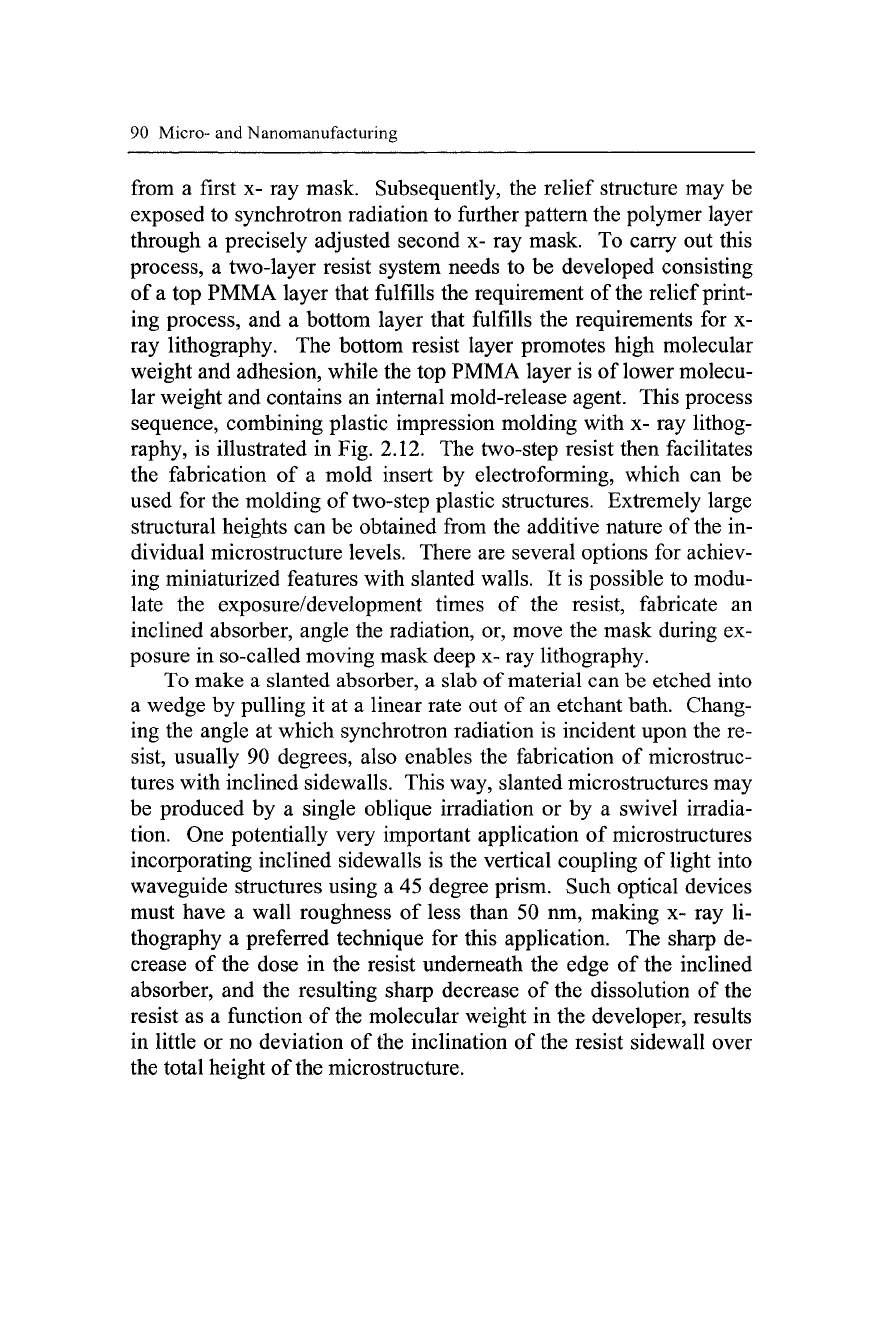
90 Micro- and Nanomanufacturing
from a first x- ray mask. Subsequently, the relief structure may be
exposed to synchrotron radiation to further pattern the polymer layer
through a precisely adjusted second x- ray mask. To carry out this
process, a two-layer resist system needs to be developed consisting
of a top PMMA layer that fulfills the requirement of the relief print-
ing process, and a bottom layer that fulfills the requirements for x-
ray lithography. The bottom resist layer promotes high molecular
weight and adhesion, while the top PMMA layer is of lower molecu-
lar weight and contains an internal mold-release agent. This process
sequence, combining plastic impression molding with x- ray lithog-
raphy, is illustrated in Fig. 2.12. The two-step resist then facilitates
the fabrication of a mold insert by electroforming, which can be
used for the molding of two-step plastic structures. Extremely large
structural heights can be obtained from the additive nature of the in-
dividual microstructure levels. There are several options for achiev-
ing miniaturized features with slanted walls. It is possible to modu-
late the exposure/development times of the resist, fabricate an
inclined absorber, angle the radiation, or, move the mask during ex-
posure in so-called moving mask deep x- ray lithography.
To make a slanted absorber, a slab of material can be etched into
a wedge by pulling it at a linear rate out of an etchant bath. Chang-
ing the angle at which synchrotron radiation is incident upon the re-
sist, usually 90 degrees, also enables the fabrication of microstruc-
tures with inclined sidewalls. This way, slanted microstructures may
be produced by a single oblique irradiation or by a swivel irradia-
tion. One potentially very important application of microstructures
incorporating inclined sidewalls is the vertical coupling of light into
waveguide structures using a 45 degree prism. Such optical devices
must have a wall roughness of less than 50 nm, making x- ray li-
thography a preferred technique for this application. The sharp de-
crease of the dose in the resist underneath the edge of the inclined
absorber, and the resulting sharp decrease of the dissolution of the
resist as a function of the molecular weight in the developer, results
in little or no deviation of the inclination of the resist sidewall over
the total height of the microstructure.
